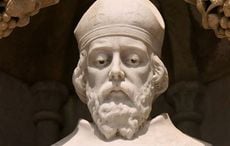James Joyce is perhaps the most famous, least-known Irishman of them all. In his native country he is admired, celebrated and persistently unread. We known him much more for his legacy than for his life.
It's as if he suspected this would be the case himself. Almost every picture taken of him is iconic and he appears somehow aloof. He wanted to maintain his distance.
Old photographs show that he walked with a cane, wore glasses and a hat, but who he was, and what he burned for? Well, that's another thing.
One of Joyce's lifelong aims was to free the Irish imagination from the nets that entangled it. The Church, the British Empire, the greasy tills and the nightmare of history were among his targets, and no one has ever been more successful at the task.
But for all of his achievements, Joyce’s critical distance has made him hard to approach. We know where he went and what he did, but who he was and what compelled him are stories that need to be better elucidated.
In "James Joyce, Portrait of a Dubliner," Alfonso Zapico has done something utterly remarkable: he has created a graphic biography, a sort of illustrated storyboard of Joyce's life from infancy to death.
Joyce and graphic novels seem like unlikely companions, but the truth is this book has a filmic sweep that takes us from his childhood in the 19th century to his long, difficult journey towards world transformative art.
At times the illustrations are informative, then scholarly, then expository, but they are almost always completely absorbing. Zapico, a native of Spain, has a straightforward method: total immersion in the life of his subject, the better to paint a portrait of the man in full.
There are many celebrated lives of Joyce, but few of them will achieve the extraordinary immediacy and pathos of Zapico's work because he is able to frame the details of his subject’s life like a film director crafting a masterwork.
It's all here – the personal toll of the years of rejection, the persistent sense of failure, the poverty and isolation, the self-imposed exile from Ireland.
Censors wanted to edit or ban Joyce’s best works, publishers ignored him or attempted to exploit him, and on top of this he suffered from debilitating physical afflictions. They're all here.
The book is the winner of Spain's National Comics Prize and it has been published to acclaim in Ireland, where people are hungry for approachable depictions of Joyce's tumultuous life.
It was love and the fate of love that transformed his life and in many ways gave it its subject. Here again comes Galway girl Nora Barnacle (she stuck to him like one), the wife and companion and muse, his holy trinity.
Zapico makes sure you understand how central her presence is in his life and art. The courtship and lovemaking sequences are among the most moving in the book.
Wherever he went he took Dublin with him, recalling it better, understanding it better from far away than when he was standing on one of its streets. Joyce understood that one of the distinctive Irish inheritances and conditions was that of exile, and he made a Jewish man the embodiment of that inner restlessness and rootlessness.
"James Joyce, Portrait of a Dubliner" is a comic, brilliant and heartfelt book that transcends whatever baggage comes with the genre to become something much more elevated and accomplished.
Joyce left, and the Irish forget those who do. It's how they cope with the pain of the severance and the implicit criticism of the leave-taking. Emigrants depart and the air swallows them. Once there was someone, and now there is not.
Those who excel, those who make a name for themselves abroad as their name at home has faded are the most troubling and the most transformative of our citizens. Joyce was supremely conscious and solicitous of his insider and outsider status, which enlivened his creative life at a cost to himself.
If we ever do come to know Joyce a little better in years to come it will because of efforts like this, which are the work of a lifetime. When you pick this book up you'll know it from the first page.
Arcade Publishing, $22.99.




Comments